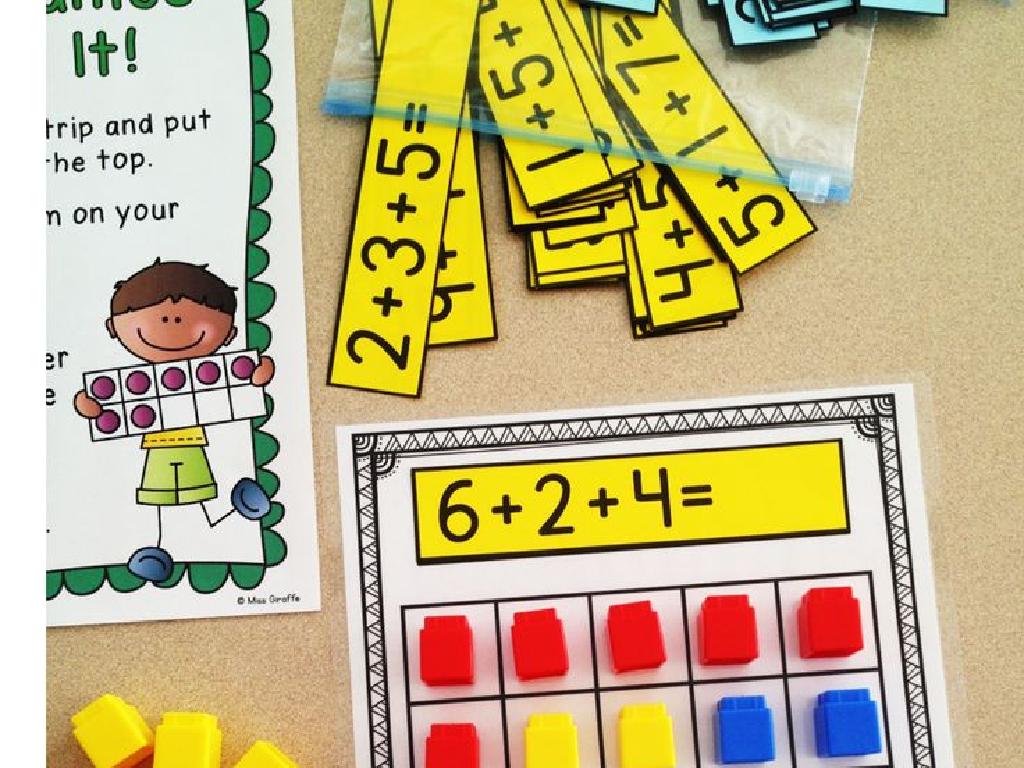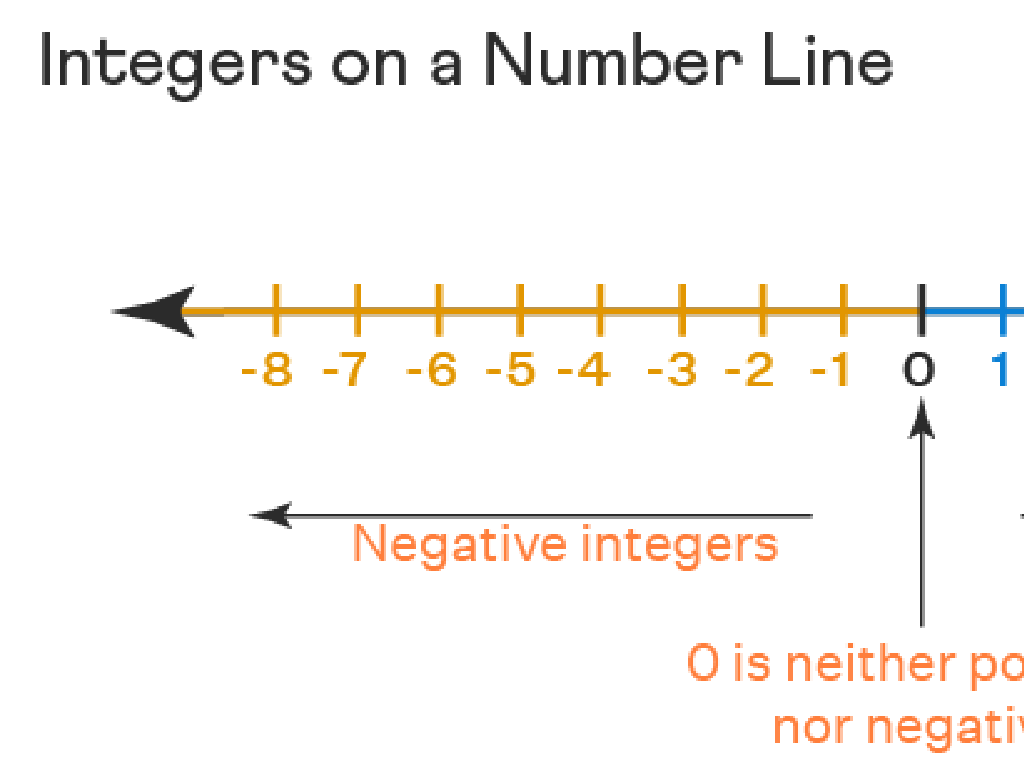Add And Subtract Decimal Numbers
Subject: Math
Grade: Sixth grade
Topic: Add And Subtract Decimals
Please LOG IN to download the presentation. Access is available to registered users only.
View More Content
Introduction to Decimals
– Decimals: Numbers with a Point
– A decimal has a whole number part and a fractional part, separated by a decimal point.
– Decimals in Daily Life
– Used in money, measurements, and more. For example, $3.75 or 1.2 meters.
– Reviewing Place Value
– Place value helps us know the value of a digit based on its position.
– Place Value: Whole Numbers vs Decimals
– Whole numbers have places like ones, tens, hundreds. Decimals have tenths, hundredths, etc.
|
This slide introduces students to the concept of decimals, emphasizing the point that separates the whole number from the fractional part. Highlight real-life examples where decimals are used, such as in currency and measurements, to make the concept relatable. Review place value by discussing the value of digits in different positions, both in whole numbers and in their decimal form. This foundational knowledge is crucial for understanding how to add and subtract decimals, which will be covered in subsequent lessons. Encourage students to think of other examples where they encounter decimals in their daily lives.
Adding Decimals: Step-by-Step
– Align decimal points vertically
– Add digits from right to left
– Example: 3.75 + 2.5
– Stack 3.75 over 2.5, align decimals, add to get 6.25
– Practice with different numbers
– Try adding 4.6 + 3.55 or 7.08 + 1.9
|
When teaching students to add decimals, emphasize the importance of aligning the decimal points to ensure accurate addition. This will help maintain the correct place value for each digit. Start by adding the digits from the rightmost column and move left, just like with whole numbers. Use the example provided (3.75 + 2.5) to demonstrate the process on the board, showing how to align the decimals and add each column. Encourage students to practice with additional examples, and provide immediate feedback to reinforce their understanding. This slide prepares students for hands-on activities and further practice problems.
Subtracting Decimals
– Align decimal points vertically
– Subtract digits column by column
– Borrow from the next column if needed
– Example: Subtract 5.6 – 3.28
– Start with the rightmost column. 0-8? Borrow from the 6, making it 5. 10-8=2, write down 2.
|
When teaching students to subtract decimals, emphasize the importance of aligning the decimal points to ensure accurate subtraction. Remind them to subtract each digit starting from the rightmost column, moving towards the left. If a digit is too small to subtract from, they should borrow from the next column to the left, just as they would with whole numbers. Use the example 5.6 – 3.28 to illustrate the process step by step. Show that after borrowing, the number becomes 4.60, and then proceed with the subtraction: 4.60 – 3.28 = 1.32. Encourage students to practice with additional examples and provide immediate feedback to reinforce their understanding.
Decimal Addition and Subtraction Practice
– Practice Example: Add 4.2 + 3.35
– Align the decimal points and add: 4.2 + 3.35 = 7.55
– Practice Example: Subtract 7.89 from 10.5
– Align decimals, then subtract: 10.5 – 7.89 = 2.61
|
This slide is designed to provide students with hands-on practice in adding and subtracting decimal numbers. Start by demonstrating how to align decimal points vertically for both addition and subtraction. For the first example, show students how to add 4.2 and 3.35 by writing one number under the other, ensuring the decimal points are lined up, and then adding each column of numbers. For the second example, guide them through the process of subtracting 7.89 from 10.5, again emphasizing the importance of decimal point alignment. Encourage students to solve these problems on their own, and then discuss the solutions as a class. This will help solidify their understanding of decimal operations and prepare them for more complex problems.
Common Mistakes in Decimal Operations
– Always align decimal points
– Stack numbers so decimals are in a vertical line
– Correctly place the decimal in answers
– The decimal point in the sum/difference stays in line with the aligned decimals
– Use zeros for placeholding
– Add zeros to equalize the number of decimal places
– Practice with examples
|
When teaching students to add and subtract decimals, it’s crucial to emphasize the importance of decimal alignment. This prevents errors in calculation and ensures accuracy. Remind students to keep the decimal points aligned vertically and that the decimal in the result should be in the same column as the aligned decimals. Stress the use of placeholder zeros to make sure all numbers have the same number of decimal places, which simplifies the addition or subtraction process. Provide plenty of practice problems that include these common mistakes so students can learn to recognize and avoid them. During the next class, review these points and have students correct misaligned problems.
Class Activity: Decimal Operations
– Pair up for decimal problems
– Solve addition & subtraction
– Use lined paper to align decimal points
– Share answers with the class
– Discuss challenges faced
– Reflect on any difficulties and how you overcame them
|
This activity is designed to promote collaborative learning and peer teaching. Students should pair up and work through a set of decimal addition and subtraction problems. Emphasize the importance of aligning decimal points to ensure accuracy. After solving the problems, each pair will share their answers with the class, fostering a discussion about different methods and strategies used. Encourage students to talk about any challenges they encountered and how they resolved them. This will help them learn from each other and understand common pitfalls in decimal operations. As a teacher, prepare to guide the discussion, clarify misconceptions, and provide additional examples if necessary. Possible activities for different pairs could include real-life scenarios involving money, measurements, or data analysis to make the exercise more engaging and relevant.
Conclusion: Mastering Decimal Operations
– Recap add/subtract decimals
– Review aligning decimal points and carrying over numbers.
– Practice is key to mastery
– Regular practice solidifies understanding and speed.
– Homework: Decimal worksheet
– Complete the provided worksheet to practice skills learned.
|
As we wrap up today’s lesson on adding and subtracting decimals, remind students of the importance of aligning decimal points and the process of carrying over numbers when necessary. Emphasize that consistent practice is crucial for mastering these operations, as it helps to reinforce the concepts and improve accuracy and speed. For homework, assign the decimal operations worksheet, which includes a variety of problems to ensure students get ample practice. Encourage them to attempt all problems and to review their notes from class if they encounter difficulties. The next class will begin with a discussion of any challenges faced in the homework.





